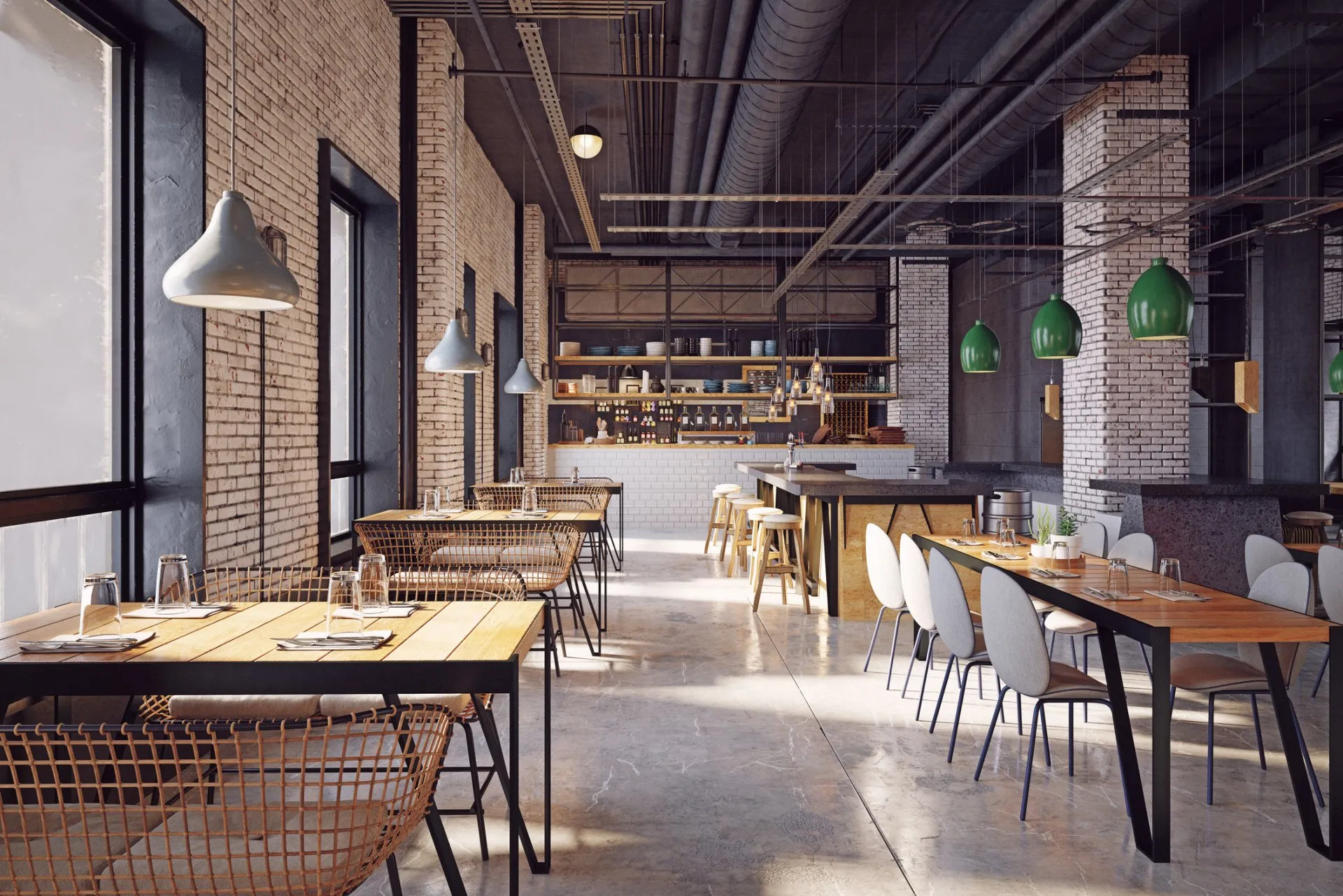How Restaurant Brands Are Adapting to COVID-19
As a result of the pandemic, many quick-serve restaurant brands are adapting to meet new preferences for how patrons want to engage with their stores. Restaurants are making physical changes to their spaces like making the most out of outdoor areas, spacing out indoor seating, emphasizing drive thru and pickup window efforts, or even renovating to a more open concept as customers become more interested in transparency and personally monitoring kitchen cleanliness.
Current design-related restaurant upgrades include implementing back-of-house cleanliness standards like removing soft and porous surfaces in favor of easier-to-clean surfaces or updating branding and signage to inform patrons about COVID regulations and compete better during this challenging time. Additionally, many restaurants are adding social distancing markers in front of host stands, bathrooms, and other common congregation areas; and installing new or improved barriers like deeper bar tops, higher plexiglass guards, and partitions between booths or tables. Upgrading to a more advanced HVAC system can also help limit shared air between occupants.
Consumers’ emphasis on cleanliness due to the pandemic will likely reach beyond the timeline of formal COVID-19 restrictions. This means that restaurants that take action sooner will be in a stronger position to maintain and grow their customer bases moving forward.
To make these projects a success, a building permit for a restaurant and various approvals are needed. Depending on the number of restaurants you have, getting permits for each upgrade can take significant time and require expertise of local requirements. Routing plans for review also need to go through different departments depending on the area, including building departments and oftentimes separate submittals to city, state, and/or county entities. That’s why it’s a good idea to employ a team of experts to handle the restaurant building permit process for you. Here are five requirements that may be necessary before embarking on restaurant upgrades.
Health and Fire Department Approvals
Most municipalities require approvals from both Health and Fire departments for new restaurant builds or renovations. These involve exhaustive building codes that ensure the health and safety of all occupants. Complex codes and requirements differ from place to place, making the approval process especially taxing for larger brands or chains looking to complete projects on multiple sites at once.
Notable health and fire safety approvals for restaurants include grease trap and waste water management systems. To keep grease out of the sewer system and prevent clogs and backups, your kitchen must be well equipped to intercept grease from sinks, deep fryers, and other fixtures. Oil and grease can solidify in sewer lines and soil absorption systems, causing problems for both onsite wastewater disposal systems and public sewage systems. Following all codes and requirements is important to avoid issues and hefty fines.
Permit expediters verify all requirements and make sure projects are submitted properly, identifying all AHJs (authorities having jurisdiction) that need approvals so you can avoid costly holdups and mistakes in your restaurant project. While some building departments will handle routing to all reviewers, others need separate submittals. For example, State, County, and/or City Departments of Environmental Health reviews and approvals may be separately required prior to Building Permit issuance, and Grease Trap and Fire submittals will need to be addressed either through the Building Department or separately depending on location. Keeping track of these vastly differing processes can cause headaches for chains or national brands looking to complete multi-site projects efficiently, so using an expert to handle this process for all sites is ideal.
Signage Updates
If you’re rebranding, implementing wayfinding signage, or adding a canopy or awning in the drive-thru area, you’ll need a permit. A recent sign-related trend for fast casual restaurants is upgrading menu boards with more advanced technology, like McDonald’s acquisition of Dynamic Yield to make their menu board technology smarter — allowing it to suggest items based on time of day, season, item availability, and whether the restaurant is busy and can accommodate complex orders.
Local regulations and processes to obtain sign permits will differ, which can make obtaining a permit for a signage upgrade lengthy and complicated, especially for larger brands or chains that will need to make the same changes in many different areas. This can hold up the entire project, leaving you behind competitors.
Local sign ordinances may restrict the size, location, and type of lighting for your sign. Permitting codes can be checked prior to sign renderings being developed to help ensure compliance when submitted for permitting. This will save you time and money working on a sign that may not ultimately be allowed in your area.
To start, you may need a sign audit to determine the effectiveness and continued compliance of your current signage, especially since COVID-19 regulations may require additional signs regarding social distancing or safe hygiene practices. A survey of your facility may help you when considering the possibilities for sign design and placement from a construction standpoint. Next, you’ll need to verify your AHJ and zoning district, confirm all necessary permit and approval requirements, and submit the required applications and materials to the appropriate places. This process can be streamlined using an expert permit expediter, allowing you to install sign updates sooner.
Interior and Exterior Renovation Permits
The customer experience is a huge focus for restaurants and retailers right now, and because of that, restaurant interiors and exteriors need to be on point both visually and spatially. If you’re considering upgrading these spaces, you may need extensive approvals. The possibilities for renovation and your goal timeline may again be obstructed by a lack of knowledge about local zoning codes and difficulties in coordinating necessary approvals.
Common permits for any interior renovation (outside of the health and fire safety requirements discussed above) include those needed for the demolition and reconstruction of walls, restroom upgrades, MEP (mechanical, electrical, plumbing) changes, and more.
If you live in a warmer year-round climate, you may be interested in permanently renovating exterior areas or obtaining additional outdoor dining space as well. Some cities are even allowing restaurants to provide additional seating in public rights of way to better facilitate social distancing standards, which requires restaurants to apply for a permit and adhere to strict standards.
If you live in a more seasonal climate, then you may be considering structural exterior restaurant updates like new roofing or siding. Since your roofing and siding protect the interior of your restaurant from damage and moisture, it’s important to make sure the entire renovation process is done safely and correctly. Handling all of the necessary submittals is the first step and may cause headaches and holdups for those not working with experts.
Many restaurant brands are shifting their focus and resources to improving drive thru and pickup window experiences in order to meet increased consumer demand for these services during the pandemic. Larger chains have been making changes in recent years to add additional windows and lanes, which have become even more important to the customer experience in 2020. A notable example is Chipotle’s drive thru pickup “Chipotlanes.”
A COVID-specific fast-casual restaurant response to social distancing practices is Shake Shack’s implementation of both drive-thru lanes and walk-up windows that they’re calling “Shack Track” stores. These remodels expand upon their previous contactless ordering and pickup options introduced earlier on in the pandemic and are becoming more important as they continue to take a cautious approach to dining room reopening plans, recently announcing that all of their currently open restaurants will be following a to-go only model in response to the recent COVID-19 spike.
As consumers increasingly seek options for a dining experience involving brand trust, customization, and improved convenience from fast-casual restaurants, we expect to see more and more restaurants adopt these kinds of changes.
System Upgrades
If you’ll be remodeling interiors, this is also an opportunity to update important systems like HVAC, plumbing, and electrical. Here again, approvals will be needed.
As mentioned earlier, HVAC system upgrades have been increasing in popularity during this time as an added measure for air quality and cleanliness. Plumbing and electrical updates often go hand in hand with other interior updates like the installation of new lighting fixtures and restroom or kitchen space renovations. Additionally, when changing the structure and layout of your restaurant, necessary system changes often come up.
Since each individual changed system will require approval, multiple areas of expertise must be applied to ensure all of the permit requirements are in place.
New Builds & Demolitions
If your strategy involves the construction of new locations or even removing existing structures for new builds, permits for restaurant building and demolition will be needed. You’ll have to work with your local Building Department to provide them with the necessary information and documentation prior to starting demolition or construction.
Since new builds and demolition are significant undertakings, you’ll need a permit and a number of approvals before breaking ground. Depending on the complexity and scope of your project, this process can take quite a bit of time.
Again, multi-site projects will complicate this process, as different areas can have vastly different applications, requirements, and rules. That’s why a permit expediting service with a national database of requirements will save you valuable time and money and help keep your project on track.
Scout Services Expedites the Restaurant Building Permit Process
Scout Services expedites and streamlines the process of obtaining a building permit for a restaurant. We handle the entire process for you — from due diligence and information gathering to package submittal and completion. Our national requirement database eliminates the need to research and navigate requirements for restaurants in different cities and jurisdictions. We identify all necessary approvals and submittals and their requirements up front, so restaurant projects can gain valuable time and money and be approved as quickly as possible.
Scout eases permit-related pain points for architects, restaurant owners, and brands by helping you avoid costly mistakes like following wrong codes, using incorrect naming conventions on plans, not obtaining approvals from all required agencies, missing items upon submittal, lack of follow-through during the review process, and not paying all applicable fees. Our expert team already understands everything that needs to be done and what goes into a permit package so they’re done correctly the first time, saving you time and money.
Connect with Scout today to put our experts to work for your restaurant project.

